Many issues continue to linger for healthcare foodservice. For example, in some hospitals the infectious disease department still determines protocols, which dictate what foodservice can and cannot do. In response, foodservice continues to navigate uncertain times and choppy waters.
“We and other operators face three main challenges,” says Leisa Bryant, MBA, MA, RD, LD. Bryant is the executive director of food and nutrition services at the University of Texas MD Anderson Cancer Center in Houston, overseeing clinical nutrition, room service, dining services and sanitation services. “One, recruiting and retaining qualified staff; two, controlling growing operational costs for food and labor and supply chain concerns; and three, meeting customer demand for food quality, variety and access with a now hybrid environment.”
Looking ahead, operators must apply critical and analytical thinking to determine which foodservice models will best support short- and long-term success for room service, retail and catering operations.
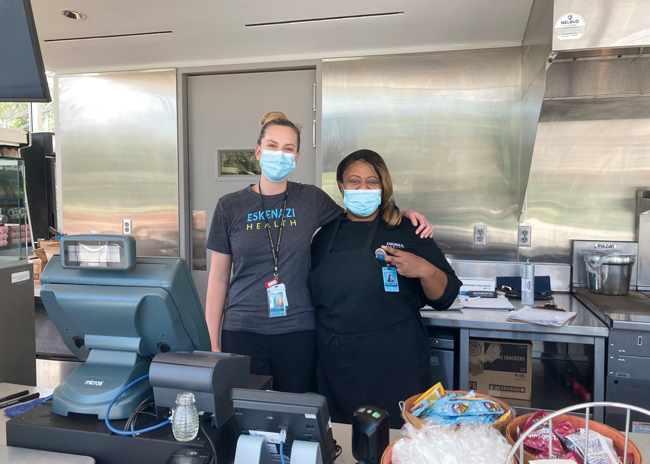 Eskenazi Health’s staff members Lois Dennison and Aeshia Tichenor review the day’s transactions. Photo by Tom Surber
Eskenazi Health’s staff members Lois Dennison and Aeshia Tichenor review the day’s transactions. Photo by Tom Surber
The Labor Puzzle
The day of reckoning for labor was in the works prior to the pandemic because many operators were already not fully staffed. Many operators say their short-term labor needs are greater than their long-term labor needs, though many remain uncertain about future staffing availability. “Pre-pandemic I was always challenged with staffing, but post pandemic I have seen our applicant pool dwindle and our candidates are now asking for
flexible work schedules and higher pay,” Bryant says.
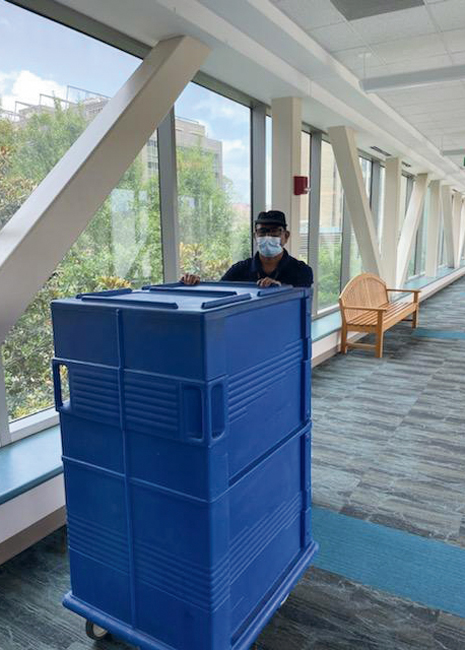 An employee transports a cart with menu items to various cafe venues. Photo courtesy of Food and Nutrition Services at The University of Texas MD Anderson Cancer CenterBryant worked with her human resources partner and compensation team at MD Anderson to revisit all job descriptions to ensure they capture all elements and tasks that fall under the job scope for a competitive wage grade. In addition, Bryant and her team transformed their leadership styles to improve communication by hardwiring all the workflows and processes with employees in mind. “We now listen and lead the whole person,” she says.
An employee transports a cart with menu items to various cafe venues. Photo courtesy of Food and Nutrition Services at The University of Texas MD Anderson Cancer CenterBryant worked with her human resources partner and compensation team at MD Anderson to revisit all job descriptions to ensure they capture all elements and tasks that fall under the job scope for a competitive wage grade. In addition, Bryant and her team transformed their leadership styles to improve communication by hardwiring all the workflows and processes with employees in mind. “We now listen and lead the whole person,” she says.
Bryant expresses much pride in a hospitality apprentice program that is in the works that draws students from high schools and a community college to work part time. “This program will build community relations, provide jobs for nontraditional career pathways, as well as establish a pipeline for future candidates,” she says.
David Reeves, system director of food and nutrition at Lee Health in Ft. Myers, Fla., says recruiting and retaining labor won’t get significantly better in the near term and this is what keeps him and his colleagues up at night. Lee Health raised minimum hourly wages to above $15 an hour and offers an above-average benefit package. “We are also flexible in how we schedule and manage people,” he says. “We can’t always attract people who are looking for the highest hourly salary, but we can attract people looking for an overall employment package at a good place to work.”
One successful new program is a revised orientation program for staff in foodservice and environmental services. One director from foodservice and one from environmental services lead the orientation for two hours. “We get employees off to a good start even before they step onto the floors of the hospital,” Reeves says. “This and making sure managers are managing properly reduces turnover. The process is evolving.”
Reeves’ department also takes a new, nonpassive approach to hiring. “We used to post jobs in newspapers or on bulletin boards, wait for people to apply for these jobs and bring them in for interviews. Now, monthly we post jobs on social media and set up hiring blitzes. People can schedule times or just walk into a specified site during a four-hour period to be interviewed by members of our leadership team. We’ve been successful in finding new people.”
Remaining flexible to function within a challenging labor market supports success for the team headed by Robin Aufdenkampe, MS, MHA, RD, FAND, assistant vice president, nutrition services, for Intermountain Healthcare based in Salt Lake City. “We’ve streamlined our workflows and staffing models as well as evaluated work that can be done remotely,” she says. “In 2020, Amelia Stocking, director of patient meal experience, implemented the Remote Patient Meal Call Center and found that we have a readily available and highly qualified applicant pool. More people are seeking remote work, and we’re reevaluating many of our positions to see if they can transition entirely or partly to remote work.”
In contrast to many operations experiencing continuing shortages in applicants, Eskenazi Health in Indianapolis finds an uptick in applicants wanting to work in foodservice. “The cost of living is going up, and people are trying to get back to a sense of normalcy and put gas in their cars,” says Seth L. Grant, CDM, CFPP, LSSBB, director of food and nutrition and director of food strategy for Social Determinants of Health, Eskenazi Health. “Of course, in order to recruit and retain, we must pay well and treat them well.”
During the past two years, Grant had a big turnover of the leadership team. In response, he applied his Six Sigma black belt certification training to introduce efficiencies by streamlining staffing in leadership and oversight positions. He hired a system executive chef, two executive sous chefs and a director of dining and community feeding. “Food and nutrition services has played an important role in our overall approach to healthcare since we were founded over 160 years ago,” Grant says. “We have a strong belief that food is medicine, and that is embedded into the fabric of our culture. I don’t see the importance of foodservice being devalued anytime soon for our organization — we’re continuing to cook from scratch and keeping the quality high — and I would hope that is the same for others across the country.”
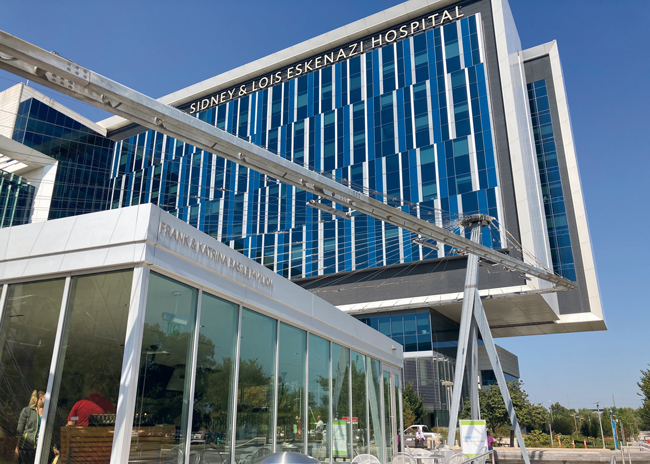
Driving Efficiencies with Technology and Convenience
Centralizing receiving, food production and delivery helps improve operational efficiencies and reduces labor requirements at MD Anderson. The culinary team produces hot and cold food for several retail operations in the production kitchen at the main hospital for other outlying MD Anderson Cafe venues. The food is then delivered across the campus by the receiving and delivery team to other venues via the skybridge or vehicle up to a mile away.
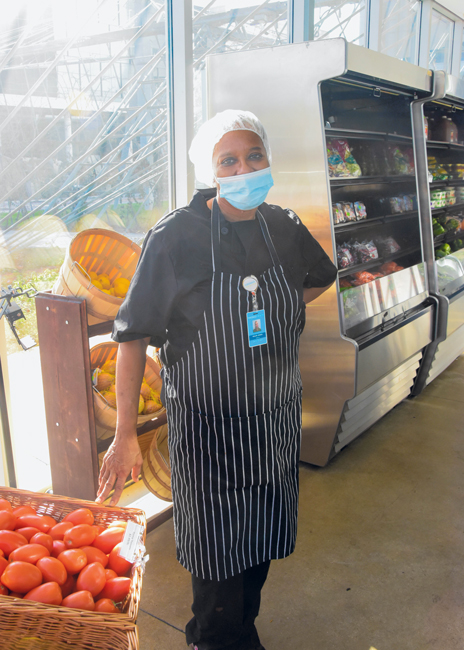 Staff member Helen Jones refreshes fresh and packaged foods at Eskenazi Health’s Fresh For You Market. Photo by Tom Surber“Centralization helps us improve productivity, timeliness for food delivery, reduce the need for skilled labor such as cooks that is in short supply as we no longer need production teams in all venues,” Bryant says. “We have also seen an improvement in quality and consistency in menu items across all cafe venues.”
Staff member Helen Jones refreshes fresh and packaged foods at Eskenazi Health’s Fresh For You Market. Photo by Tom Surber“Centralization helps us improve productivity, timeliness for food delivery, reduce the need for skilled labor such as cooks that is in short supply as we no longer need production teams in all venues,” Bryant says. “We have also seen an improvement in quality and consistency in menu items across all cafe venues.”
Offering self-checkout, unmanned cafes and more grab-and-go menu items across the campus also helps make more effective and efficient use of staff and generates faster customer throughput. The main venue, Café Anderson, was staffed with 10 cashier stations pre-pandemic; now it has six self-checkout stations and four staffed stations. The self-checkout stations accept credit cards and BadgeBucks, a declining balance system. Cashiers guide customers through the lines and assist with stocking and serving food.
MD Anderson customers can use an app to order menu items from cafes. “Many customers have a morning routine which includes a beverage,” Bryant says. App ordering is most frequently used at our coffee bars as customers will place their beverage order, and it will be ready for pickup when they arrive.
Intermountain Health also applies technology to its operations. “Meeting the needs of nonpatient consumers means offering improved technologies such as mobile ordering and payment methods, increased payment methods, advance ordering capabilities and delivery,” says Aufdenkampe.
Healthcare foodservice appears to be at an interesting intersection with respect to technology. “The pandemic almost conditioned us all to expect automation, online ordering and delivery, touchless/cashless options and patients ordering meals from their rooms,” says Grant of Eskenazi Health. “Unfortunately, I think the technology is changing so rapidly that it may be too early to commit long term to a single platform until all the dust settles, because there is a lot of competition out there and we must be innovative every day.”
For example, Grant and the Eskenazi team installed food lockers to help nurses, physicians and staff quickly pick up menu items from the retail operation and the grocery/convenience store. Customers place online orders from their phones or tablets, come to the lockers and enter a code on a keypad that opens the lockers. He’s working with the software company to find the most efficient system and hopes to add a loyalty program in the future.
Grant also renovated the dish room in 2021. The renovation included the installation of a newer dishmachine that uses less energy than its predecessor. The dish room also includes a biodigester system that turns organic waste into grey water in 24 hours or less. The biodigester uses very little electricity or water and diverts food waste into fertilizer and biogas, Grant adds. This diverts food waste from being dumped in landfills where it will turn into methane, a greenhouse gas. “We did what no one has done by plumbing our garbage disposals directly into the biodigester,” Grant says. “It took a lot of engineering.”
Meeting Customers’ Preferences
Like other foodservice segments, operators must remain on trend when it comes to menu composition. And, increasingly, this includes serving not only patients and staff but also the community at large.
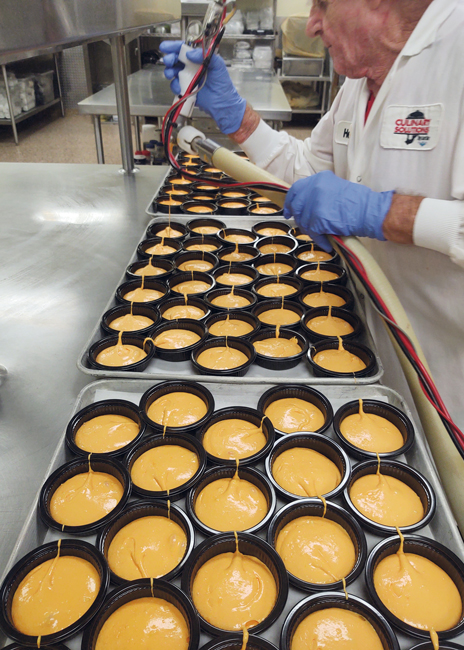 A staff member at Lee Health fills cups with a nozzle depositor. Photo courtesy of Culinary Solutions by LeeSarFor example, focusing on nutritious offerings and demonstrating how good nutrition can help to prevent and treat disease is a priority at Intermountain Healthcare. “Our primary focus has been how to provide the best possible patient meal service, and we want to continue that aim and improve the patient experience while expanding our services to visitors, staff and community members,” says Aufdenkampe. “We need to provide nutritious options that are delicious, flavorful and enticing.”
A staff member at Lee Health fills cups with a nozzle depositor. Photo courtesy of Culinary Solutions by LeeSarFor example, focusing on nutritious offerings and demonstrating how good nutrition can help to prevent and treat disease is a priority at Intermountain Healthcare. “Our primary focus has been how to provide the best possible patient meal service, and we want to continue that aim and improve the patient experience while expanding our services to visitors, staff and community members,” says Aufdenkampe. “We need to provide nutritious options that are delicious, flavorful and enticing.”
Aufdenkampe and the team’s answer is consistently offering minimally processed, high-quality options as well as more plant-forward options at all Intermountain Healthcare facilities weekly and expanding the plant-forward options on the patient menus. Like all directors, she must contend with rising food prices and chain supply disruptions.
“The value equation is quality divided by cost,” Aufdenkampe says. “To increase value we need to increase quality, decrease costs or do both.” Along those lines, Aufdenkampe and her team continue to evaluate menu items based on food and labor costs and seek to reduce the frequency of more expensive-to-produce menu items.
Corporate executive chef Alex Govern and his team introduce more readily available, lower-cost menu items such as braised fennel and vegetable side dishes. “We are going back to the basics and producing more menu items from scratch,” Aufdenkampe says. “Raw ingredients are less expensive, we control the quality and we can produce the quantities we need. We’ve also seen more crossover of menu items to the patient menu, cafe operations and the catering operations.”
In addition, the Intermountain team continues to transition to more house-made menu items such as mashed potatoes, soups and salad dressings. The team also increased the customers’ ability to customize their menu selection by offering build-your-own sandwiches, salads, pizzas, bowls and breakfasts. “As we look to decrease costs, we focus on low-cost ingredients that are readily available but are less familiar, such as polenta and grains that can be used to create a high-end experience,” Aufdenkampe notes.
Intermountain Nutrition Services also expanded grab-and-go offerings and introduced the Express Chef prepared meal options for take-home meals.
Eskenazi purchases about 70% of its food from Indiana-based farms, businesses and manufacturers. “So many of the food shortages and food supply issues didn’t impact us during the height of the pandemic,” Grant says. “However, we are starting to feel the increases in costs as our local farmers see fuel prices and labor costs increase.”
Grant’s team also focuses on from-scratch menu preparation and using ingredients without chemicals or fillers for patient and retail menus.
Cross-utilizing menu items for all operations helps the MD Anderson team control the budget as food prices increase. The team also monitors pricing fluctuations by getting continual updates from vendors.
Lessons Learned and the Future
“We need to be laser-focused on the consumers’ needs and react to their needs to improve our operations,” says Aufdenkampe. “Our nonpatient consumers have options for where to purchase their meals, and we need to ensure that our operations are easy to access, quick to provide service, able to accommodate their ordering and payment methods and offering delicious and interesting options.”
MD Anderson plans to feature more grab-and-go items, include cashless registers and centralize production at one location to then send menu items to multiple locations.
 Intermountain Health offers plant-forward dining options such as braised fennel.Grant and Reeves also see a future aimed at greater efficiency, productivity and customer satisfaction. Cultivating a team that is cross-trained to work multiple stations and finding ways to improve recruitment and retention will be critical for all operators.
Intermountain Health offers plant-forward dining options such as braised fennel.Grant and Reeves also see a future aimed at greater efficiency, productivity and customer satisfaction. Cultivating a team that is cross-trained to work multiple stations and finding ways to improve recruitment and retention will be critical for all operators.
Grant’s team, for example, turned conference rooms into recharge rooms, safe spaces away from regular work areas for nurses and physicians to relax, eat snacks and drink beverages.
Reeves of Lee Healthcare also emphasizes the importance of knowing what customers of all generations need and want from healthcare foodservices. “People today like to go out and dine and be in places that offer really good service and experiences,” he says. “They want to order using technology from their rooms or offices and pick up food whenever they want.”
At MD Anderson, in addition to using food-ordering apps, self-checkout and increased centralization of receiving, production and delivery, Bryant says they are looking into food lockers and building a large warehouse equipped to produce bakery goods, soups, sauces, catering and grab-and-go items for the entire food and dining enterprise. “This will free up space in the main building, increase productivity and allow us to produce in large quantities to meet demand.” This will also be helpful as MD Anderson expands its foodservice footprint to add more cafes and coffee bars during the next 5 to 10 years.
Everyone is considering robotics for meal delivery and possibly food production. The Ohio State University Wexner Medical Center and the University of California San Francisco at Mission Bay refer to robotic transport carts as “models.” Other models include the salad robot at Indiana University Health Bloomington and a noodle robot at Community Memorial Hospital in Ventura, Calif.
Eskenazi Health opened a hybrid grocery store and pantry called Fresh For You Market in 2017 to support the hospital’s “food as medicine” value by giving staff and patients access to healthy food. Since 2021 this market, which offers support for patients with food insecurity, resides in a new, larger location near the hospital’s entrance. It contains a full kitchen that provides space for the dining team to sell hot lunches to staff and guests. It also offers cooking classes and demonstrations by the hospital’s executive chefs and dietitians.
Grant and his team are in the process of converting a city bus into a Fresh For You Market mobile grocery and pantry with a nutrition education component. He expects it to operate by November. Community members will receive assistance from SNAP outreach program coordinators, Eskenazi Health dietitians and culinary staff who will travel in the mobile operation to areas identified as food insecure.
Stronger Than Two Years Ago
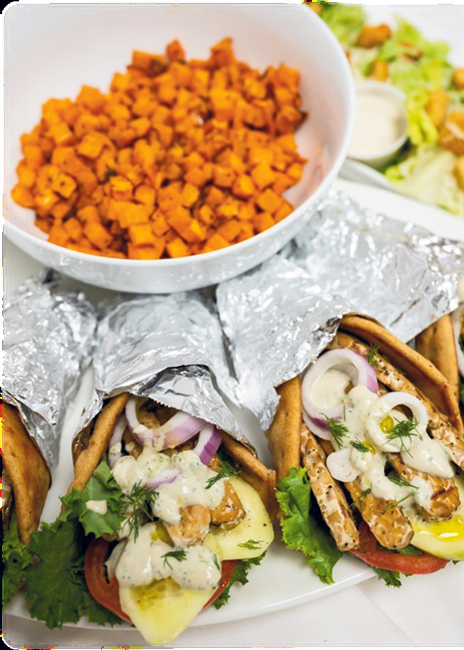 Vegan gyros rank high on the list of customer favorites at Intermountain Health. Photos courtesy of Intermountain Nutrition ServicesOne of the most poignant lessons healthcare foodservice operators have learned is how to stay nimble in the face of labor shortages and rising costs of food, equipment and supplies. They’ve also learned that change and transition can be made much more quickly than in the past. “We’re quicker to act and react,” says Reeves. “We’re more responsive to the needs of all generations who work here and come to us for services.”
Vegan gyros rank high on the list of customer favorites at Intermountain Health. Photos courtesy of Intermountain Nutrition ServicesOne of the most poignant lessons healthcare foodservice operators have learned is how to stay nimble in the face of labor shortages and rising costs of food, equipment and supplies. They’ve also learned that change and transition can be made much more quickly than in the past. “We’re quicker to act and react,” says Reeves. “We’re more responsive to the needs of all generations who work here and come to us for services.”
“Our teams are more proven and have built a new level of confidence having managed and led through uncertain and challenging times,” Aufdenkampe says. “Despite the pandemic, we’ve been able to transition six facilities to room service-style operations, standardize prices, update the patient menus and improve the Press Ganey top-box national rank patient satisfaction scores by 8% to 10%. This has increased the confidence of our caregivers and Nutrition Services leaders.”
Bryant adds that the pandemic “has disrupted foodservice operations as we know it, but it also unleashed our leadership potential to navigate the unknown, knowledge share, communicate and engage our team with compassion and be strategic, intentional and agile with our operational plans.”



